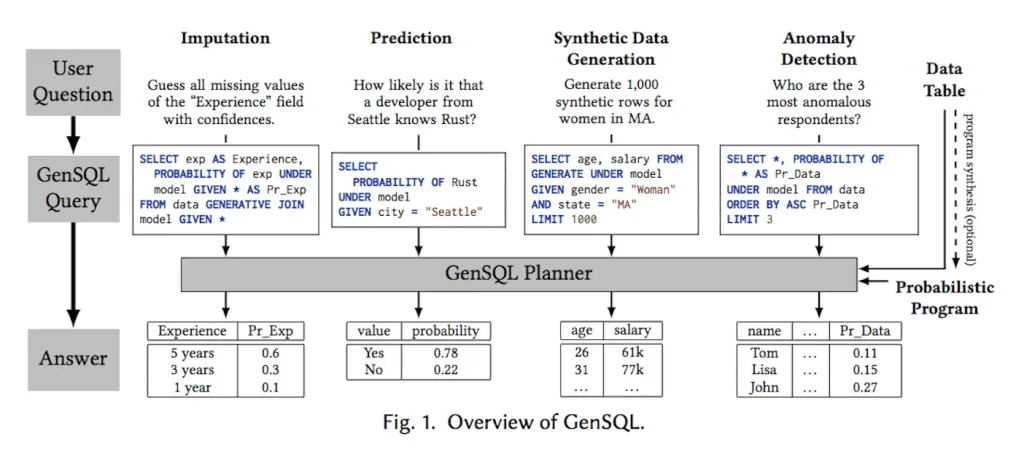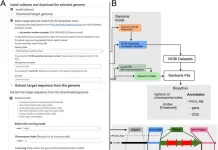In today’s world, efficiently managing and analyzing vast amounts of data is crucial for various industries. GenSQL, a pioneering system developed by researchers at Massachusetts Institute of Technology, USA, Digital Garage, Japan, and Carnegie Mellon University, USA, merges probabilistic programming with traditional SQL (Structured Query Language) to address complex data queries that standard SQL cannot handle. This article provides a comprehensive overview of GenSQL and describes its applications in various fields.
Current Challenges
The challenge in integrating complex database queries with probabilistic models arises due to the fundamental differences in the design, purpose, and operation of traditional database management systems (DBMS) and probabilistic programming systems. The objective of DBMS is to efficiently store, retrieve, and manage large volumes of structured data. It uses structured query languages to perform complex queries and transactions on tabular data. They are optimized for operations like selection, projection, joins, aggregation, and indexing.
Probabilistic Programming Systems (PPS), on the other hand, are designed to specify and infer probabilistic models. Their primary focus is on representing uncertainty, performing Bayesian inference, and learning model parameters from data. They use specialized languages to define generative models and perform inference algorithms (like MCMC and variational inference). They are optimized for tasks such as sampling, parameter estimation, and probabilistic reasoning.
PPS uses complex algorithms which are computationally expensive. Moreover, these algorithms do not support DBMS functions, and combining them is difficult.
Enter GenSQL
Imagine you’re at a party, and someone hands you a mystery cocktail. Now, you could either take a sip and hope it’s something you like, or you could use your knowledge of drinks to deduce the ingredients based on taste, smell, and appearance. GenSQL is a bit like that knowledgeable partygoer. It allows you to infer and make educated guesses about your data based on the models you have rather than unthinkingly querying it.
While SQL is highly effective for querying and managing structured data, it falls short in handling complex probabilistic queries. GenSQL bridges this gap by enabling SQL to perform sophisticated Bayesian inference, a statistical method for updating the probability of a hypothesis as more evidence becomes available.

Technical Foundations of GenSQL
GenSQL’s core innovation lies in its novel type system and denotational semantics. These elements provide a robust framework for integrating probabilistic models into SQL queries.
Type System:
In programming, a type system defines the rules for constructing valid statements. They are like the rules of grammar in language. GenSQL’s type system ensures that probabilistic queries are correctly formulated, enhancing reliability and accuracy.
Denotational Semantics:
This mathematical framework provides a rigorous foundation for understanding the behavior of programs. GenSQL ensures that probabilistic queries are interpreted correctly, maintaining consistency and predictability.
GenSQL adds some new clauses to the pre-existing ones in SQL for generating synthetic records, conditioning models on events, and computing probabilities under models. It does so by supporting models written in various probabilistic programming languages (PPLs). By integrating with PPLs, GenSQL can perform tasks like predicting new data, detecting anomalies, and generating synthetic observations.
Practical Applications of GenSQL
Here are some real-world applications where GenSQL can be used.
- Healthcare
GenSQL can be instrumental in healthcare for predictive analytics and personalized medicine. By integrating various probabilistic models, it can help predict patient outcomes, enabling customized treatment plans. GenSQL can also enhance anomaly detection by integrating PPS, ensuring that any deviations are identified immediately.
- Synthetic Biology
In synthetic biology, researchers often rely on wet labs- physical spaces where experiments are conducted. However, these can be expensive and time-consuming. GenSQL can facilitate conditional synthetic data generation, essentially creating a “virtual wet lab.” This allows researchers to simulate experiments and predict outcomes without the need for a physical lab, saving time and resources.
Other potential applications of GenSQL are in enhancing fraud detection in finance and optimizing inventory management and customer preferences in retail.
Conclusion
So, why is GenSQL a game-changer? It’s like giving SQL a turbo boost, enabling it to handle complex probabilistic queries with ease. This means better predictions, more efficient anomaly detection, and enhanced data insights across various fields.
In a world where data drives decisions, having a tool like GenSQL is akin to having a superpower. It enhances the way we interact with and analyze data, providing powerful tools to handle complex probabilistic queries. As data continues to grow in volume and complexity, systems like GenSQL will become increasingly vital, helping organizations make better, data-driven decisions.
Article Source: Reference Paper | Reference Article | An artifact providing a version of GenSQL is available on GitHub.
Follow Us!
Learn More:
Neermita Bhattacharya is a consulting Scientific Content Writing Intern at CBIRT. She is pursuing B.Tech in computer science from IIT Jodhpur. She has a niche interest in the amalgamation of biological concepts and computer science and wishes to pursue higher studies in related fields. She has quite a bunch of hobbies- swimming, dancing ballet, playing the violin, guitar, ukulele, singing, drawing and painting, reading novels, playing indie videogames and writing short stories. She is excited to delve deeper into the fields of bioinformatics, genetics and computational biology and possibly help the world through research!
















